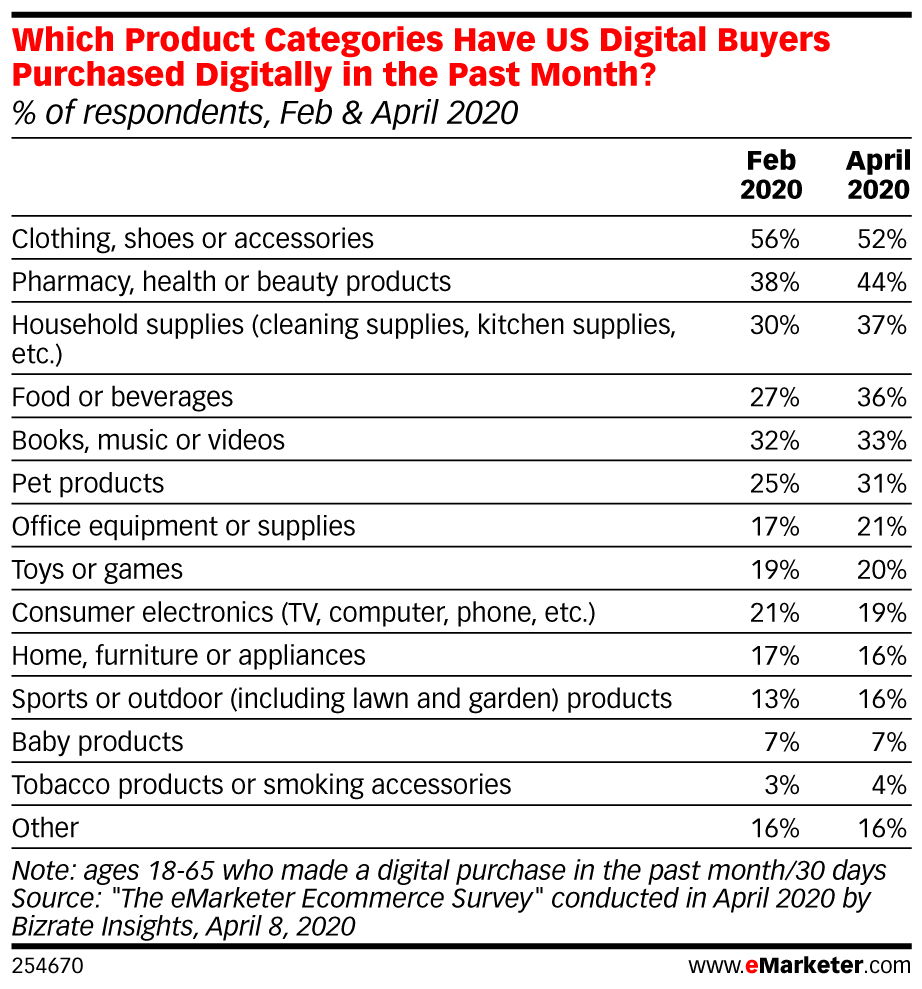COVID-19 Industry Impact Report: CPG Part 1, Food & Beverage
In March, the World Health Organization officially declared the rapidly spreading coronavirus a pandemic. As a result, consumers flocked to their local grocery stores to stock their homes with food and beverages. We’ve all seen the social media images of empty shelves, and many experienced it firsthand. While non-essential retailers have been closed, grocery stores have been open and busy with record demand for groceries as consumers prepare nearly all of their meals at home. Some food categories have experienced significant growth, and market researchers see consumer shopping patterns shifting to a new normal.
In the two months since the pandemic was declared, we have observed a major shift in shopping behavior suggesting U.S. consumers are on the verge of developing new habits altogether as temporary shifts become permanent. Retailers are learning to adapt to the shift in consumer behavior as their attention turns to shopping online in order to avoid brick-and-mortar.
What’s in our shopping carts?
Consumers are filling their pantries up with shelf-stable goods. According to Nielsen, sales of such products rose dramatically during the week ending March 7 — dried beans sales went up by 63%, rice by 58%, chickpeas/garbanzos by 47%, powdered milk products by 126%, water by 42%, and canned meat by 58%.[1] Sales of snacks have surged as people confined to their homes by coronavirus lockdowns turn to grazing on easily accessible snack foods to get through the day. For the week ending March 15, market research company, IRI, reported a 39% increase in dollar sales in core snack categories, which include candy, cookies, chips, crackers, nuts, and yogurt.[2]
Another home staple has also seen an uptick in sales - alcohol. Nielsen reports that alcohol sales were up 55% in the third week of March compared to a year ago. The increase was across the board- hard liquor sales were up 75%, wine was up 66% and beer was up 34%.[3] As bars and restaurants remain closed, Americans are stocking up on alcohol from grocery stores and liquor stores. Even when social distancing rules are eased and the country gets back to something resembling normalcy, people might still be wary of rushing back to bars or restaurants and continue to imbibe from the comfort of their own homes.
To succeed in this rapidly changing landscape, food and beverage companies need to act now in order to capitalize on potential growth. Sally Lyons Wyatt, executive vice president and practice leader, Client Insights, for IRI recommended that snack companies balance price with quality and wellness attributes to capitalize on growing sales during the coronavirus (COVID-19) epidemic.[4] She advised leveraging targeted media to reach consumers in their homes and developing online strategies to attract and retain consumers.
Predict the future by looking at the past
While nothing quite compares to COVID-19, there are clues that can be gleaned from previous periods of economic hardship. There have been a number of studies going back nearly one century that point out the advantages of maintaining or even increasing ad budgets during a weaker economy. Advertisers that maintained or grew their ad spend increased sales and market share during the recession and afterwards. According to BCG, “competitive volatility increases during downturns (for example, the rate at which businesses jump into or fall out of the Fortune 100 each year rises by 50%), reflecting an opportunity to use the downturn to your competitive advantage”. A suspension of advertising for more than six months can have deleterious effects on brand health. Marketers that focus on a long-term view on their media strategy will be well positioned down the line.
Developing an e-commerce strategy is key
It remains as important as ever for retailers and brands to recognize changing shopper attitudes and behaviors and adapt quickly to meet their needs. E-commerce continues to rise in popularity while in-store trips continue to decline. This is in direct correlation with rising concern over the virus, especially among older households and those in hardest-hit areas. Ensuring e-commerce strategies are prepared for this accelerated growth and sustained demand must be every retailer’s business priority.
In a recent Red Points survey conducted by OnePoll, roughly six in 10 U.S. internet users purchased food/beverage and consumer packaged goods digitally during the coronavirus pandemic.[5] In the eMarketer graph below, more than a third (36%) of respondents purchased food and beverages online in April 2020, up nine percentage points from February 2020.
Even with an increase in online purchasing, companies should determine which channel is best for them as grocery stores will see a continued boost in sales through COVID-19.

